May 06
The gray, blustery day from yesterday was a mere memory -- it dawned bright and warm and lovely today. We gorged ourselves on farm-fresh eggs and bacon, learned that the farm had a new litter of piglets this morning, and enjoyed teasing [] about the realities of farm life. When she asked our hostess how many piglets there were, the answer was "12, maybe 14, we'll probably end up with ten or so." Mrs. Fritz was surprised, how could you not know?
Her husband took great pleasure in explaining that sometimes the sows rolled over on them and sometimes, if she was stressed, would eat them. I thought she would faint! Since they had been out early this morning saving some of the lambs (hand-feeding triplet lambs and making sure everyone was "assigned" properly, She couldn't understand why they wouldn't be as careful about the little cute pink piglets. The answer of course, is that the pigs aren't a cash crop for the farm, they are for local consumption only, and losing a few isn't such a big deal. I'm not a farm kid (nope, city-girl to the core), but it made perfect sense to me. Not to Dr. Fritz and his wife, apparently! The reality of farm life didn't quite match the pastoral fantasy she had created. I think the idea that people would EAT the animals on the farm hadn't quite sunk in yet. Dr. Fritz got it, his wife not so much, and he teased her about it all during breakfast.
The bacon was really, really good, though.
Hadrian's Wall...or bust!
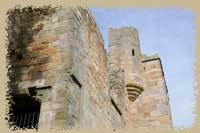 We took a quick detour to Dilston Castle, which we had seen on the way in last night. It stands in a schoolyard and I interrupted (and startled into yelping) the two guys doing work on the floor inside. Technically the little tower was not 'open', and so I didn't go inside to bother them, but I did walk around and look at the various bits and pieces that have fallen off the tower and the various windows that have been added over the years.
We took a quick detour to Dilston Castle, which we had seen on the way in last night. It stands in a schoolyard and I interrupted (and startled into yelping) the two guys doing work on the floor inside. Technically the little tower was not 'open', and so I didn't go inside to bother them, but I did walk around and look at the various bits and pieces that have fallen off the tower and the various windows that have been added over the years.
We absolutely must see Hadrian's Wall today -- we have to head north (waaaay north) for this evening. This is what happens when the planner (me) is distracted by shiny objects. Oh , well. As a start, we plugged Corbridge Roman Town into the GPS (can I once again sing the praises of the Garmin Satnav? Imagine a heavenly choir here, singing praises, with trumpets perhaps!) and sailed in to be the first visitors on the site.
We were completely alone for almost an hour, wandering among the ruins of this large Roman town as the sun rose over the site. The town is fantastically complete, although only foundations remain of all the buildings. Storage buildings for grain, officers quarters, shops, wells, barracks. The main road through the town (called Dere road} is excavated in several levels -- basically you walk down through history as each level of the town is revealed. The road bed of cobbled stones and the high stone gutters and drains runs the length of the town, splitting it in two - commerce on one side, military on the other--and
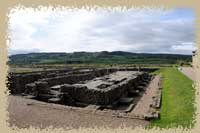 I got a bit of a chill walking along the road. Roman feet walked these same stones two thousand years ago, looked at these same buildings, took water from these fountains, stepped on these lintels and passed through these doorways. It's a feast for the imagination.
I got a bit of a chill walking along the road. Roman feet walked these same stones two thousand years ago, looked at these same buildings, took water from these fountains, stepped on these lintels and passed through these doorways. It's a feast for the imagination.
If you want to add a soundtrack to the visit, there is an extremely well done audio tour produced by English Heritage. Numbered sections in the tour guide you through each section of the town, with sound and music, and describe the town and its place in history with a vivid hand. It's well worth the rental (they're free for members - another reason to join!) to get a "live" picture of this enormous site. The small museum is interesting, too. Many of the original stones described in the audio tour are here, including the Corbridge Lion, along with an eclectic collection of artifacts found here. It's worth picking up the guidebook for the site, as well, although it’s a bit pricey. There is no other map available.
We took the scenic route to the next fort along the Wall. While the GPS definitely got us there, sometimes the routes it chooses are a bit…odd. Many more people start their tour of the Wall here at Chester Fort , and there were quite a few more people wandering around. As we walked out to the site, it started to drizzle slightly. This site is enormous, but there are fewer remains here than at Corbridge - less of the fort has been entirely excavated, I think. I'm sure there are acres of stone foundations and roads still under the undulating field, but what is above ground outlines the absolutely model-perfect Roman fort. These things were laid out on well-understood plans, with grid-like streets, and a predictable layout -- Mark is quite sure that at least part of the "might" of the Roman Empire was its ability to show up, build a thriving city in a few weeks or months and move on its merry way to build another a few miles down the road. How impressive and threatening is that? This occupying force can show up and SETTLE here in a matter of weeks without much apparent effort! What else can they do?
Roman Engineering
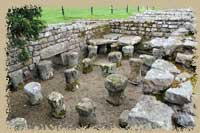 There is a remarkably complete bathhouse down along the river tank. The changing rooms, calderium and tepidarium are easy to see, and the raised floors that carried the heat through he building are still intact. The furnaces and access for the men who stoked the fires is also visible. A few minutes walking around this ancient spa and it's obvious that it would have been a luxurious, elegant place (despite being part of a military installation). It's tempting to think that this bathhouse was a crude or rough-hewn affair--what we see now is ruined stone and uneven paving and it's easy to fall into the assumption that the people who built it and used it must have been a rougher, less civilized, or less "advanced" sort. We often think the same things about the inhabitants of castles: the people living in these gray stone piles must have been more primitive than we are, less picky, more used to rough living. That's a modern sense that is entirely false: the Romans who lived here two millennia ago were smart, lively, interesting, creative people. They may not have had blackberries and elevators, or plastics and electricity, but it is a mistake to think them somehow "less' than we are.
There is a remarkably complete bathhouse down along the river tank. The changing rooms, calderium and tepidarium are easy to see, and the raised floors that carried the heat through he building are still intact. The furnaces and access for the men who stoked the fires is also visible. A few minutes walking around this ancient spa and it's obvious that it would have been a luxurious, elegant place (despite being part of a military installation). It's tempting to think that this bathhouse was a crude or rough-hewn affair--what we see now is ruined stone and uneven paving and it's easy to fall into the assumption that the people who built it and used it must have been a rougher, less civilized, or less "advanced" sort. We often think the same things about the inhabitants of castles: the people living in these gray stone piles must have been more primitive than we are, less picky, more used to rough living. That's a modern sense that is entirely false: the Romans who lived here two millennia ago were smart, lively, interesting, creative people. They may not have had blackberries and elevators, or plastics and electricity, but it is a mistake to think them somehow "less' than we are.
The baths themselves are a wonder of engineering -- heated floors, hot and cold running water, "flushing" toilets. I doubt that any modern resident would find anything to complain about. Roman baths were called Thermae, and crop up everywhere than Romans went. The baths were not only for hygiene, but also were a social activity. Romans would go to the baths and stay for several hours, soaking themselves in the different bathing rooms and relaxing with their friends. They could exercise, and eat within the walls of the bath house. The pools of cool, warm, and hot water (the frgidarium, tepidarium, and calderium) were not actually used for bathing (cleaning oneself was done by coating the skin with olive oil and then scraping off the sweat and accumulated dirt with a blade called a strigil, then rinsing thoroughly before entering the pools). Sometimes the cooler pools would be used for swimming, too. This was an outing for the day, and for the patrician roman was an important social activity. For the people here at the fort, it probably served both citizens and soldiers. There doesn't appear to have been any other bathing facilities in the city.
I walked through the stone walls of the bathhouse and imagined it as a modern day spa -- polished walls and tile floors, subtle lighting, quiet music, rooms to sit and relax and have a cool drink, and decadent baths and servants to assist you. If you've been to a spa, it's easy to see the parallel. Close your eyes, and you can see the locker room and robes and towels and hear the laughter and sighs as people soaked out their aches and pains in the hot tub. Considering that the rain was falling in a wet drizzling cloud at this point, a hot bath was a rather nice thought. I'm sure that the displaced Romans -- used to the sunny heat of Italy-- must have suffered in the bone-chilling dampness of Scotland.
We ducked into the tiny outbuilding for sandwiches and chocolate (we were reaching the 'starving to crabby' mode again) and steamed companionably in the tiny shop and watched the rain. We met a really nice Scotsman in the café, he was also walking the Wall and had ducked in to get out of the rain. He seems really, really familiar to me for some reason and I (much later) realized it was because he sounded exactly like Christian Bale (and kind of looked like him, too, at least around the mouth). He was commenting on how tired he was and I noticed that he had the same physical mannerisms as my sister and I think he also had CP. Wandering around the soft and uneven ground would tire her out instantly, I could really sympathize with the effort it would take to get around most of these sites. He limped quite severely when walking. I have enough problems managing not to pitch myself face forward into the mud…it must be doubly hard to manage when you couldn’t easily step over things. We bid him a good day and trooped off into the rain to drive to Housesteads, hoping all the way that the rain would abate.
It's not rain...it's just setting the mood
Of course, by voicing the faint hope that it would clear up and not rain….we cursed ourselves. It started to POUR rain before we got even a few miles down the road. The road parallels the wall in many places, and it's interesting to see the gaps in the hillside ditches (the real defensive part of Hadrian's Wall is not the wall, it's the huge ditch that faced it, preventing anyone from even approaching the stone wall). The road crosses this ditch a few times, which gives it a roller-coaster track that dives down to the level of the ditch and then rises back up as soon as the little valley is passed.
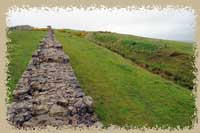 There are only a few extant sections of the wall that remain. In most places, only the ditch is visible, or perhaps a bit of the foundation walls. Builders in the nearby towns cannibalized the stone centuries ago, leaving only crumbled foundations and the faint impression of stone in the hillside. Many people start at one end of the wall, or one of the major forts (Chester or Housesteads) and walk along the wall to the next way station -- some even walk the ENTIRE wall from coast to coast. It's a tempting proposition. The landscape is beautiful, and there are interesting Roman and Celtic ruins along the length of the wall. Perhaps when we return we will join the legions that make the trek. Who knows? Adventure Girl may think it's a stupendous idea!
There are only a few extant sections of the wall that remain. In most places, only the ditch is visible, or perhaps a bit of the foundation walls. Builders in the nearby towns cannibalized the stone centuries ago, leaving only crumbled foundations and the faint impression of stone in the hillside. Many people start at one end of the wall, or one of the major forts (Chester or Housesteads) and walk along the wall to the next way station -- some even walk the ENTIRE wall from coast to coast. It's a tempting proposition. The landscape is beautiful, and there are interesting Roman and Celtic ruins along the length of the wall. Perhaps when we return we will join the legions that make the trek. Who knows? Adventure Girl may think it's a stupendous idea!
There are some sections where the wall is clearly visible, though, and we pulled off to take some pictures on the way to Housesteads. Mark bundled up and dashed out into the now-horizontal rain to take a few pictures of the stretch of wall that curved sinuously beside the road. He got soaked everywhere his raincoat didn't cover (and some places it did) and the camera got very, very wet. This freaks me out a bit and we had a small but rather fierce argument about the camera and rain in the car before we started off again. I should have worked harder to get a rain-sleeve for the camera before we left, but I was talked out of it.
Housesteads is another Roman fort, build to the same set of blueprints that the other forts show. The pouring rain is s bit daunting, as is the enormous muddy hill up to the site, but we soldier on (after I win the argument that we're going to put the camera in the camera bag, at least, to protect it from the rain). It's a 15 minute walk up the hill to see the buildings and by the time I get to the top I am wheezing and red-faced and ready to stop…and I encounter my Christian Bale look alike, standing hatless in the pouring rain. I joked that I was far too old and far too fat to be climbing hills like that, and he laughed and told me that it made no difference..I'd already made it! And, of course, that getting back down was going to be much easier. (I'll disagree there, by the way -- walking DOWN a muddy hill is actually harder than going up. I'm lucky I didn't end up sliding down ass-over-teakettle most of the way!). He pointed me in the direction that Mark had taken and I continued my puffing progress to the other end of the site, where Mark is standing on the stone wall of a house and looking into the distance to see the dark, snake-like curve of the Wall heading off into the distance.
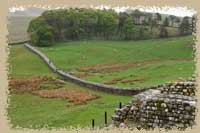 Part of the wall has been rebuilt here, to it's original height and width, just to give and idea how things were when the wall was built. It follows the curve of the fields and clings to the hillside for a couple hundred yards from where it intersects the fort. The forts are every few miles along the wall, and there are watch towers every mile or so along most of it. All I could think of, looking at that dark line, was how terrified the Romans must have been about the natives to the north. To put this much effort, this much time, this much emphasis on building a wall along the whole breadth of the country to mark their northern border and protect their frontier…how frightened they must have been about these savage northern Celts. Otherwise, why bother? It's an impressive monument to how scary and alien the Scots were.
Part of the wall has been rebuilt here, to it's original height and width, just to give and idea how things were when the wall was built. It follows the curve of the fields and clings to the hillside for a couple hundred yards from where it intersects the fort. The forts are every few miles along the wall, and there are watch towers every mile or so along most of it. All I could think of, looking at that dark line, was how terrified the Romans must have been about the natives to the north. To put this much effort, this much time, this much emphasis on building a wall along the whole breadth of the country to mark their northern border and protect their frontier…how frightened they must have been about these savage northern Celts. Otherwise, why bother? It's an impressive monument to how scary and alien the Scots were.
I offered my baseball cap to Mr. Not-Bale, when we met again in the gift shop and the rain outside looked like a solid gray sheet of water. He politely refused, even though I assured him that I had several others in the car. We actually had to turn on the air-conditioning in the car to try to dry us out -- heat just made us steam uncomfortably and fogged up the windows!
Road trip due to poor time mangement...
Off to Speyside…halfway up the country. That's a bit misleading, of course. Scotland is not a very large place, really, but it does take much longer to get places than I'm used to. It took five hours on the dual-carriageway to drive from Housesteads to the Craigallache Hotel. It passed pretty quickly, and we were very pleased not to be out in the rain, which didn't let up at all the entire trip. The long ride is my fault, of course. We were supposed to swing down, see the wall, and work our way back up north in short bursts. Instead, we spent too much time dilly-dallying as we headed south to Berwick-upon-Tweed and then across Northumberland and had to rush up north. Oh, well. If this is the worst logistical problem we have, I'm not worried. We saw some very cool stuff, met some very nice people…so what if we were a bit out of our grid-square at the end of it all.
 We arrived just in time to check in and have dinner. The Craigallache Hotel has two Michelin Rosettes and a plethora of stars and awards for their restaurant. The hotel is an old Victorian Pile and the restaurant is in the basement and sports a huge fireplace and ten or so tables. Dinner was lovely, served with strict, almost overly-formal service by a lovely young Polish girl who handled all the tables, as far as I could see. It was leisurely meal, accompanied by a nice bottle of Penfolds Shiraz. Mark had peppered duck as a starter, and roast pork for mains. I had a seafood terrine and herb-crusted salmon with pink peppercorn sauce for dinner. We almost didn't talk during dinner, so focused were we on savoring every bite. Everything was done perfectly, and we traded bites of each course and wished we could taste the other items on the menu that we hadn't ordered.
We arrived just in time to check in and have dinner. The Craigallache Hotel has two Michelin Rosettes and a plethora of stars and awards for their restaurant. The hotel is an old Victorian Pile and the restaurant is in the basement and sports a huge fireplace and ten or so tables. Dinner was lovely, served with strict, almost overly-formal service by a lovely young Polish girl who handled all the tables, as far as I could see. It was leisurely meal, accompanied by a nice bottle of Penfolds Shiraz. Mark had peppered duck as a starter, and roast pork for mains. I had a seafood terrine and herb-crusted salmon with pink peppercorn sauce for dinner. We almost didn't talk during dinner, so focused were we on savoring every bite. Everything was done perfectly, and we traded bites of each course and wished we could taste the other items on the menu that we hadn't ordered.
Wobbling upstairs after dinner found us in the Quaitch Bar -- famous for its 700 different scotches-where we settled in to a couple of chairs in the corner. We struck up a conversation with two women from South Africa (who were touring Scotland as a "girl's vacation") and a charming couple from Germany. Everyone was here for the Speyside Whisky Festival, and we were all awed and impressed by the bar manager, Daniel, who cheerfully discussed scotch tasting, single-malt attributes, and the general history of whisky in Scotland (whilst handling a full bar full of people, mind you) and as the bar emptied out, he even set up a tasting of the "Six regional malts" for us, on the fly. He was absolutely fantastic! He walked us through the malts, poured all six, and then left us to discuss them .
Omens and portents
One of the malts, from the highlands, was very sea weedy and salty, and it prompted [] and Petra to relate the funniest travel story I have ever heard. I may not be able to do it justice, but here goes:
Leo and Petra are avid travelers, and spent some time in a Japanese monastery while on vacation, trying to absorb some of the spiritual "energy" there. They stayed at the monastery itself, in the monk's cells and lived with the monks and followed their schedule. This included morning prayers, which rousted them out of bed and into their thin robes to kneel in the courtyard and pray. It was early. It was cold. They knelt on the stones and prayed. It went on and on and on, the rocking and the chanting.
"Don't worry," they were told. "When we're done here, there will be a lovely breakfast with all sorts of delicious dishes"
Fortified by the thought of good food when this was over, Leo persevered. When it was over and they congregated at the table in the open dining hall for breakfast, he sat down at the table filled with covered dish upon covered dish. A veritable feast!
Opening one dish revealed….seaweed. No matter, there were dozens of others.
The second dish…another variety of seaweed.
Each dish, more and more and more seaweed. Green, brown, gray. Seaweed, seaweed, seaweed.
Utterly bereft, and sure that he was going to starve, Leo closed his eyes and beseeched the heavens, "Oh, god, if there is a god, please, please, please, show me a sign!"
And he opened his eyes and looked up, over the wall of the monastery, and there it was.
A Sign.
Pink and Orange.
A DUNKIN' DONUTS sign.
We fell about laughing like hyenas, until it was actually painful to breathe and we had stopped making any noise except wheezing and snorting. Heh.
Daniel came and sat with us as the bar closed, and he was very pleased that we had enjoyed our tasting. Sitting and talking and relating our own experience was the best thing he had heard all day - we had made it all personal, made it all something that we could share. That was how scotch was meant to be enjoyed. He was tickled pink that it worked out that way.
Sometime after 1am we made our way to our (quite small, but very comfortable) room and fell asleep.

